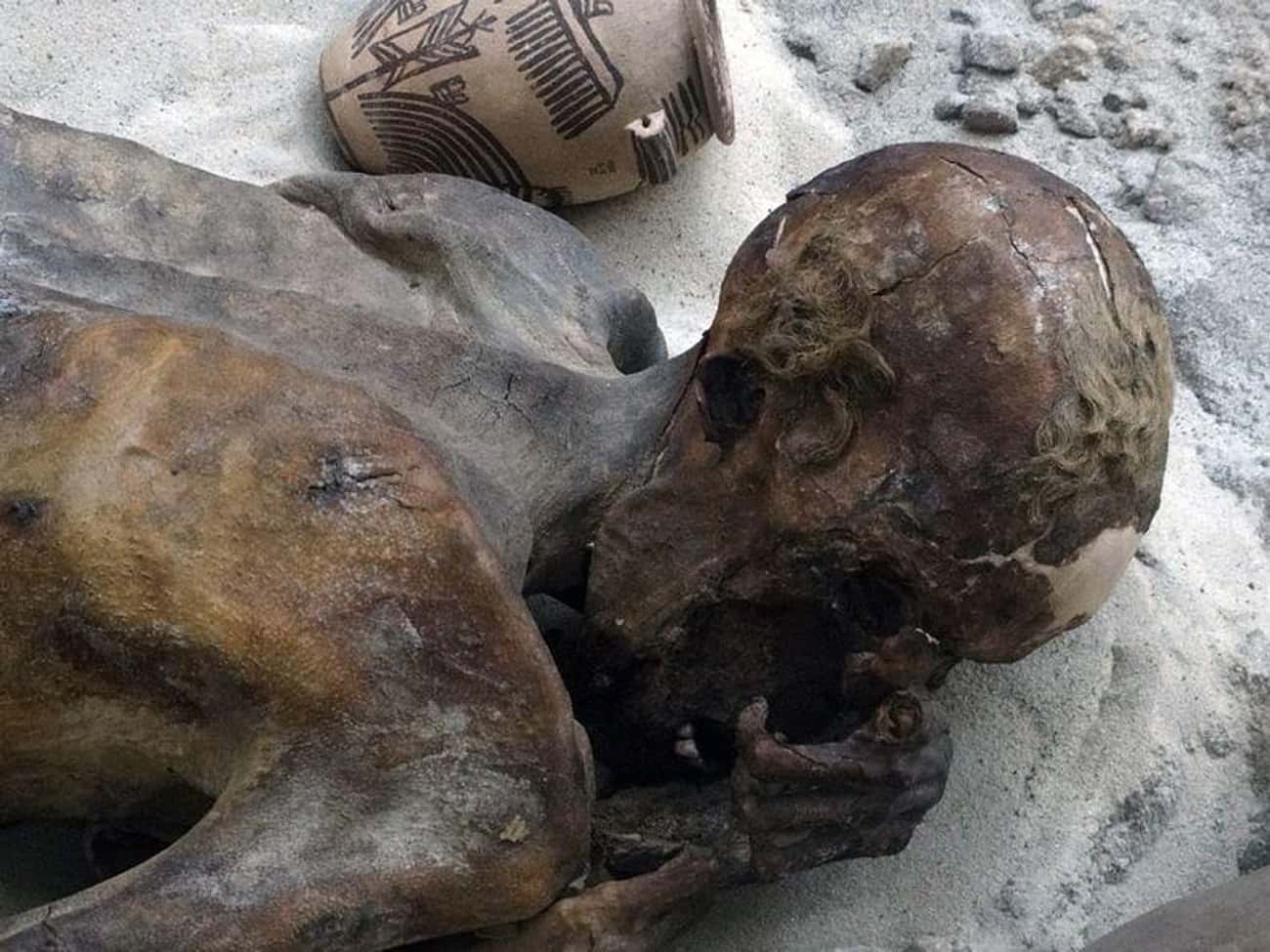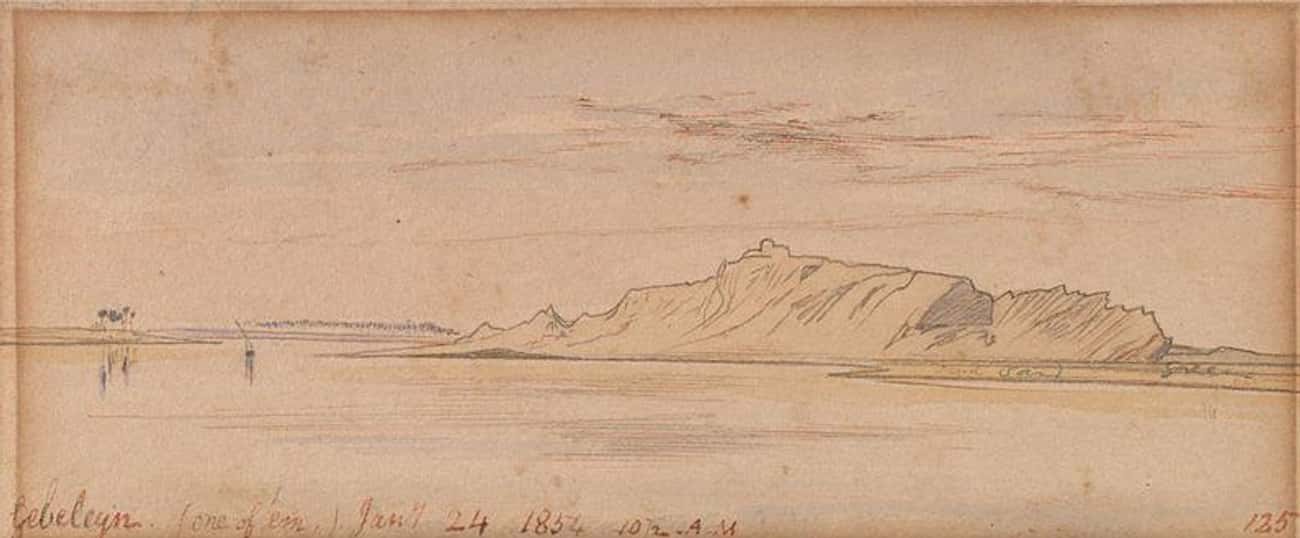Are you my mummy? The Gebelein Man, located in the British Museum, is a naturally mummified corpse that dates approximately 5,000 years. Moreover, this artifact was preserved naturally through the environment, as opposed to more deliberate and natural measures that mummies are usually known for.
For all you history nerds and non-history nerds alike, the Gebelein Man’s body holds a wealth of information about his life. You can even see the stab wound that killed him. Anyone like tattoos? The Gebelein Man actually has the world’s oldest known figural tattoos. Read more about the Gebelein Man below.
Gebelein Man Was Most Likely Murdered

Although the wound on Gebelein Man’s back has been visible for over 100 years, the technology allowing experts to study it in-depth is relatively new. Researchers used visual-imaging devices to conduct a virtual autopsy, peering inside Gebelein Man’s body to analyze bones and internal organs (including his brain), which remain intact.
Researchers determined the weapon that stabbed Gebelein Man most likely consisted of copper. They theorize the attack came from behind, with the blade driven into his back – most likely catching him by surprise. The shoulder blade and ribs beneath the wound also show damage.
The Egyptian region where researchers discovered Gebelein Man was likely at peace when he was killed, making his death a murder.
He Was Unofficially Known As ‘Ginger’ Due To His Small Tufts Of Red Hair

Given Gebelein Man remains one of the most well-known mummies in the world, he naturally received a nickname from museum-goers. Unofficially known as “Ginger,” the moniker came from the small tufts of red hair still visible on his scalp, a further testament to how well his body was preserved.
Their Tattoos Look Like Smudges Under Natural Light
The Gebelein mummies have been hiding secrets for around a century, including one feature ordinarily visible to the naked eye: tattoos. To researchers, the tattoos on their dehydrated skin looked like smudges. So, until updated infrared technology became available, they couldn’t determine the true nature of the mysterious markings.
Older equipment would have damaged the priceless mummies, as infrared radiation produces images, but also heat. Heating a 5,000-year-old mummy could prove disastrous. Luckily, technology advanced to the point where infrared imaging could be done digitally, without harming the specimen – finally leading to the discovery of the mummies’ tattoos.
Gebelein Man Was The First Man From The Era Known To Have Tattoos

Until the infrared analysis of Gebelein Man, researchers believed only females from that era of Egyptian history possessed tattoos. Gebelein Man’s tattoos came as a surprise, and include a lot of symbolism from the period.
One of his tattoos, a bull, represented male virility in ancient Egypt. Researchers at the British Museum believe the bull and ram on the mummy’s skin served as “symbols of power and strength.”
Not only is this mummy the first male of the era with tattoos, but he and Gebelein Woman are the first humans known to have “figural tattoos,” which were thought not have occurred until a thousand years after their lifetime.
The Bodies Were Preserved By Desert Conditions In Shallow Graves

Egypt is known for its mummification techniques. The Gebelein mummies, however, didn’t undergo the more popular version of the process. They were created unintentionally, by the environment rather than human hands.
Their organs were not removed and preserved, and their bodies didn’t get wrapped in the style of later mummies. The individuals received simple burials, placed in a crouched or fetal position under linen wrappings, inside shallow graves. Thus, the bodies quickly grew dehydrated from the arid climate.
In Predynastic Egyptian Culture, Tattooing Wasn’t For Young People
In spite of the long-held belief that tattoos in ancient Egypt were reserved for concubines and dancers, the latest theory poses tattoos denoted status and wisdom. According to Dr. Renee Freidman, a researcher at the British Museum:
It’s not the nubile young things, the older women were tattooed… They were probably the wise women, and the tattoos were there to show their initiation into cult practices and their knowledge of medicine. It wasn’t just meant for the gratification of men.
Gebelein Man remains unique in being both male and young, which defies the old thesis. Experts estimate his age between 18 and 21 years old when he died.
Gebelein Man Has Been A Museum Attraction For More Than A Century

First discovered in 1896, Gebelein Man went on display at the British Museum in 1901. He’s remained a hit ever since, drawing crowds of visitors as part of the museum’s Department of Ancient Egypt and Sudan.
Gebelein Man is their best-known mummy, and his peers include individuals from several different eras in Egypt’s history.
The Burial Items Displayed With Gebelein Man Aren’t His But They Match The Period And Area Where He Lived

The type of burial a person undergoes says a lot about their culture and beliefs. Gebelein Man is not displayed with his exact burial goods, but is instead surrounded by items that might have been found with him.
Judging from this particular mummy, one can assume burials in predynastic Egypt involved shallow graves lined with reed mats, with the bodies placed in the fetal position and their hands by their face.
To ensure the dead reached the afterlife successfully, ancient Egyptians included items in the graves thought to help with the process – like jars of food and stone tools.
Some Of The Tattoos Remain Difficult For Experts To Understand
In addition to the bull and ram tattoos found on Gebelein Man, researchers also located a line of “S” figures on his contemporary, Gebelein Woman. The four “S” shapes in a row on her shoulder, accompanied by a staff-like tattoo on her upper arm, still confuse researchers studying the mummies.
One theory posits the figures represent batons used in ritual dances, while the staff marking is a “crooked stave,” a symbol of high status and power. Whatever their meaning, the tattoos were placed on highly visible parts of Gebelein Woman’s body.
The Mummies Date Back To Just Before Upper And Lower Egypt Were Unified

Although they came from the region now known as Egypt, the Gebelein mummies date to a time before, or just as, the country became unified. Experts theorize the individuals lived sometime between 3351 and 3017 BCE, making them over 5,000 years old.
Most historians agree Upper and Lower Egypt unified in either 3118 BCE or 3150 BCE – though which leader united the country remains a topic of debate.
The Tattoos Carried A Heavy Significance In The Ancient World

The tattoos on Gebelein Man and Gebelein Woman mark the oldest known figural tattoos in the world (versus abstract and geometric tattoos). The discovery of the body art was monumental: it proved tattooing existed in Africa 1,000 years earlier than previously thought. The ancient Egyptians, however, were not the only ones with tattoo traditions.
Cultures like the Māori in New Zealand have practiced facial tattooing for hundreds of years. And before the Gebelein mummies’ tattoos were discovered, Ötzi the Iceman from the Italian-Austrian Alps held the record for oldest body art.
In his case, researchers believe he received his tattoos as a healing practice, since they rest on acupuncture pressure points.
The Museum Has Several Mummies From Gebelein

The Gebelein mummies in the collection at the British Museum were discovered at the ancient Egyptian city of Gebelein. The city existed before the country unified, and is now a historic site rather than a functioning town.
Gebelein was located 25 miles south of the ancient Egyptian city of Thebes, which is now part of the city of Luxor.

